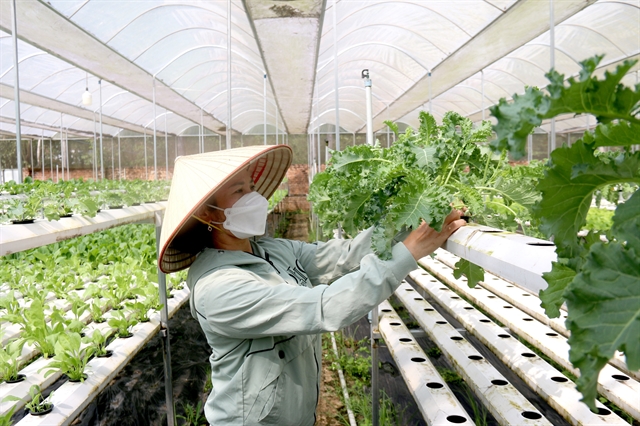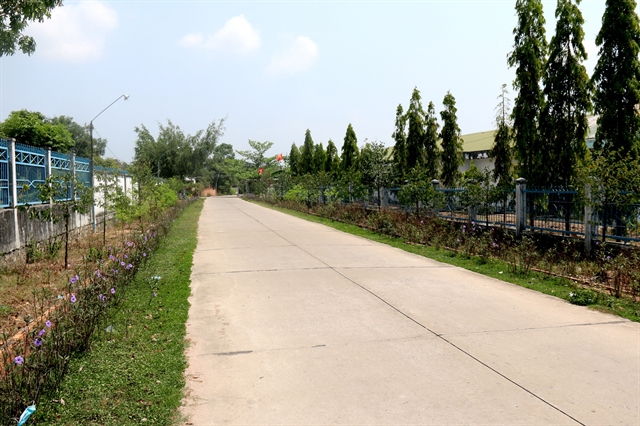
BÌNH THUẬN – Building new-style rural areas has helped the south- central province of Bình Thuận significantly improve the lives of its rural residents.
Bình Thuận, one of the country’s driest provinces, has had 69 communes, or 74 per cent of its total number, recognised as new-style rural areas since beginning to implement a national programme in 2010.
To be recognised as a new-style rural commune, the programme sets out 19 criteria related to infrastructure, transport, irrigation, electricity, environment, income, education, healthcare, social security, and culture.
Phú Quý and Đức Linh districts have also achieved the recognition, while Phan Thiết City is currently being evaluated.
Nguyễn Hữu Phước, deputy director of the province Department of Agriculture and Rural Development, said the look of the province’s rural areas have changed significantly, becoming greener, cleaner and more beautiful.
“The development gap between urban and areas has been narrowed,” Phước, also head of the province’s coordination office for new-style rural areas, said.
All of the province’s 93 communes met an average of four of the 19 criteria in 2010 and 16.6 by the end of last year.
In the beginning authorities identified transport as the most important of the 19 criteria, and prioritised its development since the transport system was poor and many roads had deteriorated, causing difficulties for rural people to travel and carry goods.
In 2011-20 the province paved 1,300km of rural roads with cement or asphalt.
Now 87 of all communes meet the transport criteria.
The province has also been focusing on developing irrigation since it has hot weather and frequently suffers from drought in the dry season.
With funding support from the Government and its own resources, Bình Thuận Province has built large irrigation works such as reservoirs to store water.
They help secure water to irrigate 114,500ha, or 50 per cent of total farmlands.
The province has restructured agriculture and encouraged production and consumption stakeholders to create linkages among themselves.
Farmers have switched to other, mostly high-value, crops and fruits on nearly 8,900ha of unproductive rice fields.
The province, the country’s largest dragon fruit producer, has nearly 12,400ha growing the fruit to Vietnamese good agricultural practices (VietGAP) standards.
It has more than 33,000ha under the fruits and an annual output of 700,000 tonnes, of which 15 per cent is consumed domestically and the rest is exported, mostly to China.
The average income per capita in rural areas has increased to VNĐ46.6 million (US$2,000) now, thrice the 2010 figure.
Targets
Bình Thuận Province has identified agriculture and rural development as strategic factors in socio-economic development from now through 2045.
It targets having 75 communes and five of 10 districts meeting all new-style rural area criteria by 2025.
It aims to have no poor households by 2025, and double the average income of rural people by 2030.
Phước, deputy director of the Department of Agriculture and Rural Development, said to achieve the targets the province would step up promotion of investment in agriculture and rural development and use of advanced techniques.
It would also tweak its investment policies and reform administrative procedures for the purpose, he said.
Ngô Minh Trang, head of the province Rural Development Sub-department, said to build new-style rural areas the province is also speeding up implementation of the national one commune – one product (OCOP) programme, especially promotion of its 70 OCOP products.
The programme would help sell speciality products and thus improve rural incomes, he said.
“This year the province opened two sites for showcasing and selling OCOP products.”
A resolution passed at the province Party Congress for 2020-25 identified industry, tourism and agriculture as the three pillars of the economy, and prioritised them for development.
The province is shifting from merely growing crops into an agricultural economy so that farmers have steady outlets.
The province is developing high-tech agriculture, value chains for crops and rural tourism and adapting its agriculture to climate change.
With its coastal and mountainous terrains, the province is growing vegetables, medicinal plants and fruits which require less water than rice.
The People’s Committee has instructed the Department of Agriculture and Rural Development to ensure agriculture meets VietGAP, GlobalGAP and organic standards.
The province is developing concentrated farming areas to grow quality produce for export. – VnExpress News

- Reduce Hair Loss with PURA D’OR Gold Label Shampoo
- Castor Oil Has Made a “Huge” Difference With Hair and Brow Growth
- Excessive hair loss in men: Signs of illness that cannot be subjective
- Dịch Vụ SEO Website ở Los Angeles, CA: đưa trang web doanh nghiệp bạn lên top Google
- Nails Salon Sierra Madre
 VnExpress News The News Gateway of Vietnam
VnExpress News The News Gateway of Vietnam





